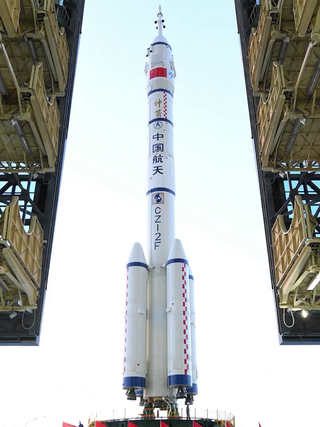
The Long March 2F, also known as the CZ-2F, LM-2F and Shenjian, is a Chinese orbital carrier rocket, part of the Long March 2 rocket family. Designed to launch crewed Shenzhou spacecraft, the Long March 2F is a human-rated two-stage version of the Long March 2E rocket, which in turn was based on the Long March 2C launch vehicle. It is launched from complex SLS at the Jiuquan Satellite Launch Center. The Long March 2F made its maiden flight on 19 November 1999, with the Shenzhou 1 spacecraft. After the flight of Shenzhou 3, CPC General Secretary and President Jiang Zemin named the rocket "Shenjian" meaning "Divine Arrow".

The space program of the People's Republic of China is directed by the China National Space Administration (CNSA). China's space program has overseen the development and launch of ballistic missiles, thousands of artificial satellites, manned spaceflight, an indigenous space station, and has stated plans to explore the Moon, Mars, and the broader Solar System.
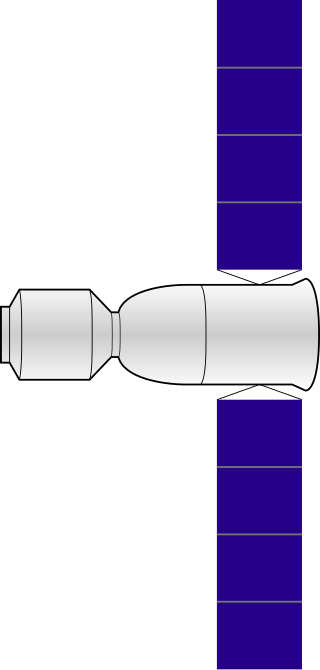
Shenzhou 6 was the second human spaceflight of the Chinese space program, launched on October 12, 2005 on a Long March 2F rocket from the Jiuquan Satellite Launch Center. The Shenzhou spacecraft carried a crew of Fèi Jùnlóng (费俊龙) and Niè Hǎishèng (聂海胜) for five days in low Earth orbit. It launched three days before the second anniversary of China's first human spaceflight, Shenzhou 5.

The Xichang Satellite Launch Center (XSLC), also known as the Xichang Space Center, is a spaceport of China. It is located in Zeyuan Town (泽远镇), approximately 64 kilometers (40 mi) northwest of Xichang, Liangshan Yi Autonomous Prefecture in Sichuan.
Shenzhou 4 – launched on December 29, 2002 – was the fourth uncrewed launch of the Chinese Shenzhou spacecraft. Two dummy astronauts were used to test the life support systems.
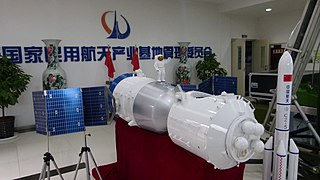
Shenzhou 7 was the third human spaceflight mission of the Chinese space program. The mission, which included the first Chinese extra-vehicular activity (EVA) carried out by crew members Zhai Zhigang and Liu Boming, marked the commencement of the second phase of the Chinese government's Project 921.
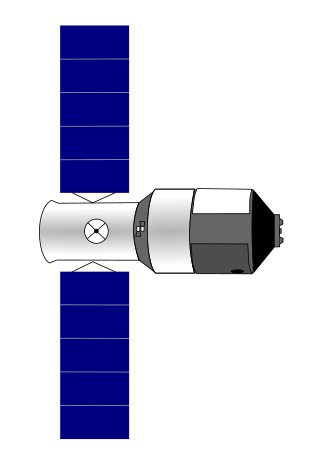
The Tiangong program is China's space program to create a modular space station, comparable to Mir. This program is independent and unconnected to any other international space-active countries. The program is part of the China Manned Space Program that began in 1992. The core module, the Tianhe was finally launched on 29 April 2021 marking the start of the Tiangong Space program deployment.

Tiangong, officially the Tiangong space station, is a space station constructed by China and operated by China Manned Space Agency (CMSA) in low Earth orbit between 340 and 450 km above the surface. It is China's first long-term space station, part of the Tiangong program and the core of the "Third Step" of the China Manned Space Program (CMS); it has a pressurised volume of 320 m3, slightly over one third the size of the International Space Station.

Shenzhou 8 was an uncrewed flight of China's Shenzhou program, launched on 31 October 2011 UTC, or 1 November 2011 in China, by a Long March 2F rocket which lifted off from the Jiuquan Satellite Launch Center.

Shenzhou 9 was the fourth crewed spacecraft flight of China's Shenzhou program, launched at 18:37:24 CST, 16 June 2012. Shenzhou 9 was the second spacecraft and first crewed mission and expedition to dock with the Tiangong-1 space station, which took place on 18 June. The Shenzhou 9 spacecraft landed at 10:01:16 CST on 29 June in the Inner Mongolia Autonomous Region. The mission's crew included the first Chinese female astronaut, Liu Yang. The next mission was Shenzhou 10, which launched on 11 June 2013.

Shenzhou 10 was a crewed spaceflight of China's Shenzhou program that was launched on 11 June 2013. It was China's fifth crewed space mission. The mission had a crew of three astronauts: Nie Haisheng, who was mission commander and previously flew on Shenzhou 6; Zhang Xiaoguang, a former PLAAF squadron commander who conducted the rendezvous and docking; and Wang Yaping, the second Chinese female astronaut. The Shenzhou spacecraft docked with the Tiangong-1 trial space laboratory module on 13 June, and the astronauts performed physical, technological, and scientific experiments while on board. Shenzhou 10 was the 2nd and final expedition and mission to Tiangong-1 in this portion of the Tiangong program. On 26 June 2013, after a series of successful docking tests, Shenzhou 10 returned to Earth.

The China Manned Space Program, also known as Project 921 is a space program developed by the People's Republic of China and run by the China Manned Space Agency (CMSA), designed to develop and enhance human spaceflight capabilities for China. It was approved on 21 September 1992 and has been in operation ever since. The CMS director is currently Zhou Jianping; he has held this position since 2006, after taking over from Wang Yongzhi, who served as the first director from 1992 to 2006.

Tiangong-1 was China's first prototype space station. It orbited Earth from September 2011 to April 2018, serving as both a crewed laboratory and an experimental testbed to demonstrate orbital rendezvous and docking capabilities during its two years of active operational life.
The Chinese Deep Space Network (CDSN) is a network of large antennas and communication facilities that are used for the interplanetary spacecraft missions of China. It is managed by the China Satellite Launch and Tracking Control Center General (CLTC), which reports to the People's Liberation Army Strategic Support Force Space Systems Department. They also deal with radio-astronomical and radar observations.

Tianhe, officially the Tianhe core module, is the first module to launch of the Tiangong space station. It was launched into orbit on 29 April 2021, as the first launch of the final phase of Tiangong program, part of the China Manned Space Program.
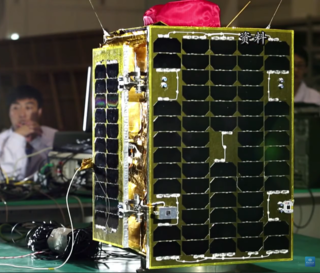
Jilin-1 is China's first self-developed commercial remote sensing satellite system. The satellites are operated by Chang Guang Satellite Technology Corporation and named after Jilin Province where the company is headquartered. The first set of satellites were launched by Long March 2D in Jiuquan Satellite Launch Center on 7 October 2015, at 04:13 UTC. All launched Jilin-1 satellites are in sun-synchronous orbit (SSO).

Tianzhou 4 was the fourth mission of the Tianzhou-class unmanned cargo spacecraft, and the third resupply mission to Tiangong Space Station carrying 5 tons of cargos and 1 ton of propellant. It is the largest load capacity cargo spacecraft that is on active duty. It launched on 9 May 2022, docking successfully with the Tiangong space station at the aft port 6 hours after launch. Like previous Tianzhou missions, the spacecraft launched from the Wenchang Satellite Launch Center in Hainan, China on a Long March 7 rocket.












